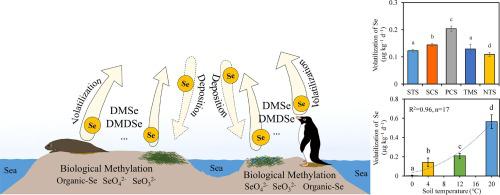Environment International ( IF 10.3 ) Pub Date : 2020-10-30 , DOI: 10.1016/j.envint.2020.106189 Wenjuan Ye , Linxi Yuan , Renbin Zhu , Xuebin Yin , Gary Bañuelos

|
Maritime Antarctica harbors a large number of penguins and seals that provide considerable input of selenium (Se) originating as guano into terrestrial ecosystems. Subsequent Se emissions via biomethylation and volatilization from these sources of Se have not been studied. Here, penguin colony soils (PCS) and adjacent tundra marsh soils (TMS), seal colony soils (SCS) and adjacent tundra soils (STS), and normal upland tundra soils (NTS) were collected in maritime Antarctica. For the first time, Se volatilization and speciation were investigated in these soils through incubation experiments using chemo-trapping method. The Se contents in PCS, SCS, STS and TMS were highly enriched compared with NTS, with organic matter-bound Se accounting for 70%-80%. Laboratory incubations yielded the greatest Se volatilization rates (VRSe) in PCS (0.20 ± 0.01 μg kg−1 d−1), followed by SCS (0.14 ± 0.01 μg kg−1 d−1) at low temperature (4 °C). Soil frozen-thawing induced 1–4 fold increase in VRSe, and the VRSe continuously increased until the soils fully thawed. The VRSe showed a significant positive correlation (R2 = 0.96, p < 0.01) with soil temperature. Methylated Se species were dominated by dimethylselenide (DMSe) in PCS and dimethyldiselenide (DMDSe) in SCS. Our results imply that the combination of climate warming, frozen-thawing processes, and high-Se inputs from sea animals will significantly increase tundra soil Se volatilization in maritime Antarctica. High VRSe from penguin colony soils, and significantly elevated Se levels in the mosses close to penguin colony, suggest that volatilization of Se from penguin colony soils play an important role in the mobilization and regional biogeochemical cycling of Se in maritime Antarctica.
中文翻译:

海洋南极寒带苔原土壤中的硒挥发
海洋南极洲拥有大量的企鹅和海豹,它们提供了大量的鸟粪来源的硒(Se)进入陆地生态系统。这些来自硒源的生物甲基化和挥发引起的后续硒排放尚未得到研究。在这里,在海洋南极洲收集了企鹅殖民地土壤(PCS)和邻近的苔原沼泽土壤(TMS),海豹殖民地土壤(SCS)和邻近的苔原土壤(STS)和正常的陆地苔原土壤(NTS)。首次通过化学诱集的温育实验研究了这些土壤中硒的挥发和形态。与NTS相比,PCS,SCS,STS和TMS中的硒含量高,有机物结合硒占70%-80%。实验室温育产生最大的Se挥发速率(VR Se)放入PCS(0.20±0.01μgkg -1 d -1)中,然后在低温(4°C)下注入SCS(0.14±0.01μgkg -1 d -1)。土壤冻融导致VR Se增加1-4倍,并且VR Se持续增加直到土壤完全融化。VR Se显示出显着的正相关(R 2 = 0.96,p <0.01)与土壤温度。甲基化的硒物质在PCS中以二甲基硒化物(DMSe)和SCS中的二甲基二硒化物(DMDSe)为主。我们的结果表明,气候变暖,冻融过程和海洋动物的高硒投入的结合将显着增加海洋南极苔原土壤中硒的挥发。来自企鹅群落土壤的高VR Se以及靠近企鹅群落的苔藓中Se的含量显着升高,表明企鹅群体土壤中Se的挥发在海上南极Se的动员和区域生物地球化学循环中起着重要作用。











































 京公网安备 11010802027423号
京公网安备 11010802027423号